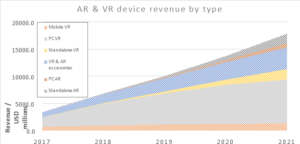IDTechEx Research believes that the market for AR/VR and “everything in between” headsets is already approaching $3.4 Billion in 2017 and is expected to reach $37 billion by 2027. The report highlights that there are differences in how companies define the different technology. The company said that the difference is really dependent on how much of the real world is seen through the headset.
The firm said that the high volume of mobile VR will not contribute significantly to total revenues due to the low unit value. From 2021 onwards, growth will be transferred to stand alone AR, propelled forward by the launch of high performing headsets and reduced power consumption that will lead to longer battery life and independence from the grid. Standalone VR will also make its mark, although its exact value proposition is not fully clear or even distinctly separate from standalone AR; in standalone VR, the challenge of adequate energy storage that will allow longer times between charging is magnified due to the requirements for running a high end GPU computer along with a high resolution display. In fact, both energy storage and displays for AR & VR applications are both extensively discussed in the report, given how critical these components are for future generations of headsets.
Analyst Comment
It will be interesting in ten year’s time to look back at the range of forecasts there were for AR/VR and to see who got close – if anyone does! The reality, of course, is that nobody knows.
At the SID AR & VR conference where I was running a panel (report in our full SID report), someone said that VR takes you into a new world, but AR brings something into your world. That’s a good way of understanding the difference. What was clear from the activities at the SID is that display companies are working very hard to solve the display-related barriers to great VR performance.

